- Top Employee Onboarding Software
- Why Use Employee Onboarding Software?
- Key Features of Effective Onboarding Software
- How To Choose The Right Onboarding Software?
- Which is the Best Onboarding Software?
- Frequently Asked Questions (FAQs)
- What Is Upskill And Reskill?
- Difference Between Reskilling And Upskilling
- Upskilling for Workplace Advancement
- Reskilling for Career Transformation
- Crafting Successful Upskill and Reskill Strategies
- Upskill And Reskill Strategizing: Things to Keep in Mind
- Measuring the Impact of Skill Development Initiatives
- Frequently Asked Questions
- What’s a Skill Gap?
- Employee Skill Gap Analysis: Why Do We Need It?
- How To Conduct Employee Skill Gap Analysis?
- Addressing Skill Gaps Through Training and Hiring
- Utilizing Skills Gap Analysis for Strategic Planning
- Leveraging Employee Skill Gap Analysis: Things To Keep In Mind
- Frequently Asked Questions
- Transformative Role of AI in Talent Acquisition
- Impact of AI on Business Recruiting
- Overcoming Challenges in AI-Driven Talent Acquisition
- Starting with AI in Talent Acquisition
- Future Landscape of AI in Talent Acquisition
- Frequently Asked Questions
- HR In The Hot Seat - Challenges With Evolving Workforce
- Mastering Effective HR Management: Tips For Overcoming Challenges
- Summing Up
- The Future of HR: Key Trends for 2024
- Skill-Based Hiring
- Prioritizing Employee Experience, Engagement & Well-being
- AI-Empowered Workforce Evolution and Its Impact
- Taking Diversity, Equity, and Inclusion Beyond Mandates
- Hybrid and Remote Work
- Embracing the Gig Economy and Blended Workforce
- Transparent HR Practices
- Climate Change Adaptation in HR Practices
- Leveraging HR Analytics for Data-Driven Decisions
- Continuous Learning & Development to Improve Productivity
- The Office Buzz in 2024
- Bottom Line - HR Operating Model Needs A Shift
- Importance and Impact of Recognizing Employee Birthdays
- Professional Birthday Wishes for Employees (All Experience Levels)
- Personalized Birthday Wishes for Employees in Different Roles
- Fun Birthday Wishes for Employees (with Templates)
- Birthday Wishes for Remote Employees
- Heartfelt Birthday Wishes for Employees
- Belated Birthday Wishes for Employees
- Simple & Sweet Birthday Wishes for Employees
- Celebrating Employee Birthdays: Ideas and Traditions
- Tips and Ideas for Sending Birthday Wishes to Employees
- Closing Thoughts
- Frequently Asked Questions
- What Is An Employee Referral?
- Benefits of Implementing Employee Referral Programs
- Setting Up an Effective Employee Referral Program
- Employee Referral Email
- Employee Referral Scheme
- Overcoming Challenges of Employee Referrals
- Companies with Best Employee Referral Programs
- Employee Referral Programs: Best Practices
- Closing Thoughts
- Frequently Asked Questions (FAQs)
- Importance of Team Building Activities
- Types of Team Building Activities
- Outdoor Team Building Activities for Employees
- Indoor Team Building Activities for Employees
- Easy Team Building Activities for Remote Employees
- Team Building Activities For New Employees (Icebreakers)
- Fun Team Building Activities for Different Goals
- To Boost Communication and Collaboration
- To Reduce Stress Levels and Promote Well-being
- Aligning Team Purpose and Values with Strategic Activities
- Final Remarks
- Frequently Asked Questions
- Importance of Employee Appreciation Quotes
- Work Appreciation Quotes for Employees
- Employee Appreciation Quotes for Hard Work Recognition
- Employee Appreciation Quotes for Teamwork and Collaboration
- Appreciation Quotes for Celebrating Employee Anniversaries and Milestones
- Employee Appreciation Quotes for Strong Work Ethics
- Employee Appreciation Quotes for Project & Goal Completion
- Employee Appreciation Quotes for Quality of Work
- Employee Appreciation Quotes for Creativity and Innovation
- Appreciation Quotes for Managers
- Peer-to-Peer Employee Appreciation Quotes
- Appreciation Quotes for Employees Leaving the Company
- Employee Appreciation Quotes for Thoughtful Gestures
- Funny Employee Appreciation Quotes
- Short Employee Appreciation Quotes
- Employee Appreciation Quotes for Different Roles
- Employee Appreciation Quotes for Senior Leadership
- Creative Ways to Use Employee Appreciation Quotes
- Summary
- Frequently Asked Questions (FAQs)
- What is Employee Satisfaction?
- Importance of Employee Satisfaction
- Objectives of Employee Satisfaction
- Employee Satisfaction vs. Employee Engagement
- Key Reasons for Employee Dissatisfaction
- Strategies for Improving Employee Satisfaction
- Ways to Measure Employee Satisfaction
- Best Practices for High Employee Satisfaction
- Final Remarks
- Frequently Asked Questions (FAQs)
- How to Craft Effective Employee Appraisal Comments
- Key Areas to Focus in Performance Review
- Comments On Hard Work & Dedication
- Assessing Interpersonal Skills
- Evaluating the Ability to Collaborate & Work in Teams
- Gauging Punctuality
- Commenting on Communication Style
- Reviewing Time Management and Productivity
- Leadership in Performance Appraisals
- Assessing Creativity & Innovation
- Evaluating Problem-Solving Abilities
- Recognizing Flexibility and Dependability in Reviews
- Employee Appraisal Comments for Different Roles
- Summary
- Frequently Asked Questions (FAQs)
- Employee Grievance Meaning
- Importance of Employee Grievance Process
- Types of Workplace Grievances
- Reasons for Employee Grievances
- Employee Grievance Procedure
- Steps in the Employee Grievance Handling Process
- Employee Grievance Form Example
- Final Remarks
- Frequently Asked Questions (FAQs)
- What is Company Culture?
- Importance of Company Culture
- Types of Company Culture
- Factors Contributing to Organizational Culture
- Assessing & Developing Corporate Culture
- Company Culture - It’s not just Perks or Feels
- Good Company Culture Examples
- Developing Company Culture: Best Practices
- Closing Thoughts
- Frequently Asked Questions (FAQs)
- What is Employee Empowerment?
- Benefits of Empowering Employees
- Employee Empowerment vs. Micromanagement
- Strategies for Effective Employee Empowerment
- Role of Managers in Fostering Empowerment
- Organizational Structure Supporting Empowerment
- Overcoming Barriers to Employee Empowerment
- Frequently Asked Questions (FAQs)
- What is Employer Branding?
- Importance of Employer Branding Strategy
- How to Build an Employer Branding Strategy?
- Strategies for Building a Strong Employer Brand
- How to Measure and Boost Your Employer Branding Success?
- Examples of Strong Employer Brand Strategy
- Best Practices for an Effective Employer Branding Strategy
- Closing Thoughts
- Frequently Asked Questions (FAQs)
- What are Employee Wellness Programs?
- Importance of Employee Wellness Programs
- Examples of Employee Wellness Programs
- Real-Life Examples of Corporate Wellness Programs
- Strategies for Encouraging Participation
- Supporting Diverse Employee Needs
- Creating Comprehensive Wellness Programs
- Measuring the Impact on Business and Employees
- Closing Thoughts
- Frequently Asked Questions (FAQs)
- What is Talent Management?
- Developing a Winning Talent Management Strategy
- Models and Frameworks
- Tips for Framing Effective Talent Management Strategy
- Looking Ahead: Recent Trends in Talent Management
- Frequently Asked Questions
- Role of AI in HR: Addressing Common Challenges
- Artificial Intelligence in HR Processes
- AI Tools for HR Functions
- How to Adopt AI in HR?
- Addressing Challenges of AI in HR
- Ethical and Responsible AI Use
- The Future of AI in HR
- Closing Thoughts
- Frequently Asked Questions
- What is Performance Management?
- Elements of Effective Performance Management
- Performance Management Cycle
- Differentiating Performance Management
- Benefits of Performance Management With Examples
- Challenges faced in Performance Management and their Solutions
- Future Trends in Performance Management
- Frequently Asked Questions
- Changing Role of HRM
- Changing Role Of HR Manager
- Technology and the Changing Role of HRM
- The Rise of AI and Machine Learning in HR
- Mobile Technology's Impact on HR Practices
- The Significance of People Analytics in HR
- Navigating the Future of HR Technology
- Final Remarks
- Frequently Asked Questions
- Compensation Management Meaning
- Compensation Types
- Breaking Down The Compensation Management Process
- HR Software for Compensation Management
- Current Trends in Compensation Management
- Frequently Asked Questions
- Defining Flexible Work Arrangements
- Flexible Working: Advantages for Businesses
- Challenges of Flexible Work Arrangements
- Crafting Flexible Working Practices
- Types Of Flexible Work Arrangements
- Comparing Flexible Work Arrangements
- Real-Life Examples of Flexible Work Arrangements
- Final Remarks
- Frequently Asked Questions
- Conflict Resolution Meaning
- Conflict Origins
- Tried & Tested Conflict Resolution Strategies
- Methods of Conflict Management at Workplaces
- Conflict Resolution Strategies: Top Management Tips
- Summary
- Frequently Asked Questions
- Career Development Meaning
- Career Development Plan for Employees
- Career Development in HRM: Growth Ideas For Employees
- Issues in Career Development and Their Solutions
- Closing Thoughts
- Frequently Asked Questions
- Understanding Compensation
- Exploring Benefits
- Difference between Compensation and Benefits
- Compensation & Benefits Structure
- Final Remarks
- Frequently Asked Questions
- Defining Recruitment in HR Practices
- Exploring Talent Acquisition in HR
- Understanding Talent Acquisition vs Recruitment
- When to Recruit or Acquire Talent
- Talent Acquisition vs Recruitment: Responsibilities
- From Recruitment To Talent Acquisition
- Closing Thoughts
- Frequently Asked Questions
- Work Culture Meaning
- Types of Work Cultures
- Components of Culture
- Best Work Culture Examples Set By Top Companies
- Creating a Positive Work Culture
- Closing Thoughts
- Frequently Asked Questions
- Defining Learning vs Development
- Importance of Learning and Development
- L&D Activities for Employees
- Choosing the Right L&D Activities
- Crafting an Effective L&D Strategies
- Aligning L&D Strategy with Business Goals
- Designing Engaging Learning Journeys
- Learning and Development Process: KPIs
- ROI in Learning and Development
- Emerging Trends in L&D
- Closing Thoughts
- Frequently Asked Questions
- What Is Leadership Development?
- Key Skills for Leaders
- How To Develop Leadership Skills in Organizations?
- What Is A Leadership Development Program?
- How To Develop A Leadership Development Program?
- Example of A Leadership Development Plan
- Benefits of Leadership Development Training
- Frequently Asked Questions
- Defining Diversity Training
- Importance of Diversity Training
- What are the Types of Diversity?
- Types of Diversity Training Methods
- Diversity Training Activities
- Choosing A Diversity Training Program
- How to Implement Diversity Initiatives
- Best Diversity Training Programs (Real-Life Examples)
- Improving the Effectiveness of Diversity Training
- Tracking and Evaluating the Results of DE&I Training Efforts
- Essential Elements for Successful Diversity Training
- Closing Thoughts
- Frequently Asked Questions
- Defining Occupational Health & Safety
- Evolution of Workplace Health and Safety
- Identifying Common Workplace Hazards
- Global Impact on Occupational Health & Safety
- Managing Employee Health and Safety Risks
- Occupational Health and Safety Problems
- Future of Occupational Health and Safety
- Frequently Asked Questions
- Employee Orientation Defined
- Employee Onboarding Explained
- Orientation and Onboarding: Understanding the Difference
- Importance of Orientation and Onboarding
- Crafting Comprehensive Integration Strategies
- Quick Tips for Orientation and Onboarding
- Frequently Asked Questions
- What is HR Metrics?
- Importance of HR Metrics
- HR Metrics Examples in Recruitment
- HR Metrics Examples in Employee Retention
- HR Metrics Examples in Revenue
- Other Common HR Metrics
- Soft HR Metrics Example
- HR Metrics Formula
- Utilizing HR Metrics Effectively
- Future of HR Metrics
- Summary
- Frequently Asked Questions
- Defining Decision Making Process
- Key Concepts In Decision Making
- Decision Making & Problem Solving
- Tips For Improving Decision Making Skills
- Selected Practice Questions & Answers
- Conclusion
- Frequently Asked Questions (FAQs)
- A case(s) of miscommunication
- The devil is in the (resume) details
- One for the complaints!
- What is an Exit Interview?
- Benefits of Exit Interviews to an Organization
- How to Conduct Exit Interviews?
- Exit Interview: Sample Questions to Ask
- Overcoming Challenges of Exit Interviews
- Exit Interviews: Best Practices
- Closing Thoughts
- Frequently Asked Questions
- Technology in the Workplace
- Benefits of Tech Integration
- Technology in the Workplace: Key Functions
- How Technology Normalized Remote Work
- Workplace Technology: Top Tools and Software
- Steps for Effective Technology Implementation
- Overcoming Tech Implementation Challenges
- Ethical Considerations in Tech Use
- Keeping Pace with Tech Trends
- Closing Thoughts
- Frequently Asked Questions
- What is Ethical Leadership?
- Principles of Ethical Leadership
- Difference between Ethics and Integrity
- Importance of Ethical Leadership
- Ethical Leadership in Practice
- Overcoming Challenges
- Frequently Asked Questions
- Embracing Change Management
- Mastering People Analytics
- Enhancing Stakeholder Relationships
- Navigating Diversity, Equity & Inclusion
- Upholding Ethics and Data Privacy
- Developing Critical Thinking
- Advancing Negotiation Techniques
- Fostering Inter-departmental Collaboration
- Building Resilience in HR
- Frequently Asked Questions
- What is Mental Health?
- Benefits of a Mentally Healthy Workforce
- Prioritising Mental Health: Creating a Culture of Support
- Final Remarks
- Frequently Asked Questions
- Gen Z vs Millennials - What is the difference?
- Retain and Engage Gen Z Employees: Need and Strategies
- Strategies to Retain and Engage Gen Z Employees
- Rethinking Requirements
- Final Remarks
- Frequently Asked Questions
- Understanding Millennial Leadership Needs
- Key Leadership Skills for Millennials
- How To Develop Millennial Into Leaders
- Additional Strategies to Develop Leaders
- Learning Preferences of Millennials
- Benefits of Investing in Millennial Leaders
- Closing Thoughts
- Frequently Asked Questions
- Understanding Fluff
- Examples of Interview Fluff
- Identifying Interview Fluff
- Addressing Interview Fluff
- Seeing Through the Fluff
- Frequently Asked Questions
- What is the Gender Pay Gap?
- Is the Gender Pay Gap Real?
- Factors Affecting the Gender Pay Gap
- How Age Impacts Women’s Earnings
- The ‘Motherhood Penalty’
- Education's Role in Wage Differences
- Racial and Ethnic Disparities in Pay
- Closing the Gender Gap
- Frequently Asked Questions
- Top Weirdest Late-To-The-Office Excuses
- The Fine Art of Balancing Wit and Wisdom in HR
- Understanding Social Media Recruiting
- Crafting Your Social Media Recruitment Strategy
- Implementing Your Strategy Effectively
- Popular Platforms for Recruitment
- Navigating the Downsides of Social Media Recruiting
- Measuring Success and Adjusting Strategy
- Summary
- Frequently Asked Questions
- Who Is A High Potential (HIPO) Employee?
- Characteristics of A High Potential (HIPO) Employee
- High Potential Employee Identification
- Grooming High Potential Employees
- Why High Potential Employees Leave
- How Do You Retain High Potential Employees?
- High Potential Employee Development: Best Practices
- Closing Thoughts
- Frequently Asked Questions
- What is Digital Fluency?
- Why Digital Fluency Matters?
- Difference between Digital Literacy and Digital Fluency
- Key Components of Digital Fluency
- Achieving Digital Fluency
- Overcoming Challenges
- Future of Workforce Digital Fluency
- Frequently Asked Questions
- What is Loud Quitting?
- Pros and Cons of Loud Quitting
- Reasons Behind the Trend
- Analyzing the Impact
- How HR Can Navigate the Loud Quitting Uproar
- Preventive Strategies
- Closing Thoughts
- Frequently Asked Questions
- Defining Emotional Intelligence in HR
- Why Emotional Intelligence Matters for HR Leaders
- How To Build Emotional Intelligence in HR
- Integrating EQ into HR Practices
- Impact of EQ on Company Culture
- Emotional Intelligence in HR: Major Challenges
- Final Remarks
- Frequently Asked Questions
- Understanding Internal Job Posting
- Internal Job Posting: Pros and Cons
- The Internal Job Posting Process
- Writing Effective Ads for Internal Job Posting
- Strategies for Success of Internal Job Posting
- Summary
- Frequently Asked Questions
- Understanding Workplace Bias
- Common Types of Bias in HR
- Closing Thoughts
- Frequently Asked Questions
- What is a Dry Promotion?
- Dry Promotion: Pros and Cons for Companies
- Impact of Dry Promotion on Employee Retention
- Preventing Talent Loss After Dry Promotions
- Closing Thoughts
- Frequently Asked Questions
- What Is A Stay Interview?
- Importance Of Stay Interviews
- Benefits And Challenges Of Stay Interviews
- Planning And Conducting Stay Interviews
- Stay Interviews: 20 Sample Questions To Ask
- Best Practices For Effective Stay Interviews
- Summary
- Frequently Asked Questions
- Who Is A Boomerang Employee?
- Reasons For Returning
- Benefits Of Hiring Boomerang Employees
- Challenges Of Rehiring
- Interviewing Boomerang Candidates: Sample Questions
- Enhancing The Hiring Process
- Making Informed Decisions
- Final Remarks
- Frequently Asked Questions
- Talent Pipeline Meaning
- Significance of Talent Pipelines
- Advantages of a Talent Pipeline
- Building a Talent Pipeline
- Maintaining a Talent Pipeline
- Attracting Top Talent
- Implementing the Strategy
- Frequently Asked Questions
- What is Micromanagement?
- Recognizing Micromanagement
- Leadership versus Micromanagement
- Keeping Micromanagement in Check
- Beyond Micromanagement
- Summing Up
- Frequently Asked Questions
- Recognizing Signs Of A Bad Hire
- Understanding The Impact On Teams
- Dealing With A Bad Hire
- Preventing Future Bad Hires
- Closing Thoughts
- Frequently Asked Questions
- Defining Neurodiversity
- Importance of Neurodiversity in the Workplace
- Moving Towards Inclusive Environments
- Final Remarks
- Frequently Asked Questions
- Understanding the Generation Gap
- Multigenerational Workforce: Debunking Stereotypes
- Strategies for Bridging the Gap
- Benefits of a Multigenerational Workforce
- Final Remarks
- Frequently Asked Questions
- Defining Productivity Theatre: All Show, No Go
- 5 Key Drivers of Fake Productivity
- Solutions to Combat Productivity Theatre
- Summary
- Frequently Asked Questions
- Defining Grumpy Staying
- Why do Grumpy Stayers not Leave?
- Recognizing the Signs
- Exploring the Causes
- Understanding the Impact
- Addressing the Issue
- Taking Action: Addressing Grumpiness with Empathy
- After the Conversation
- When Grumpy Staying Continues
- Closing Thoughts
- Frequently Asked Questions
- The Rationale Behind Office Peacocking
- Impact on Company Culture
- Impact on Employees
- Case Studies: Examples of Office Peacocking
- The Downside: Potential Pitfalls of Office Peacocking
- Practical Tips for Implementing Office Peacocking
- Frequently Asked Questions
- 13 Common Mistakes Young Managers Make
- Strategies To Avoid Mistakes (Individual Growth)
- How Young Managers Can Boost Teamwork
- Learning From Errors
- Summary
- Frequently Asked Questions
- Understanding Great Regret - What causes the shift shock?
- Impact of Great Regret
- How can HR help make the situation better?
- Closing Thoughts
- Frequently Asked Questions
- Understanding the HR Budget
- Key Components of an HR Budget
- Preparing an HR Budget Step-by-Step
- Importance of HR Budgeting in Management
- Final Remarks
- Frequently Asked Questions
- What are Pre-Employment Assessments?
- Importance of Pre-Employment Testing
- Types of Pre-Employment Assessments
- 15 Tips for Creating Effective Pre-Employment Assessments
- Closing Thoughts
- Frequently Asked Questions
- Exploring the Productivity Paradox
- Understanding the Impact of Solow Paradox
- Productivity Paradox: Why it Matters for Recruiters & HRs
- Identifying Causes and Challenges
- Strategies for Enhancing Productivity
- AI & the Modern-Day Productivity Paradox
- Beyond Technology: Building a Productive Workforce
- Summary
- Frequently Asked Questions
- Understanding the Great Reshuffle 2.0
- Preparing Leaders for the Change
- HR’s Role in Handling Great Reshuffling 2.0
- The Way Ahead
- Frequently Asked Questions
- Definition Of Managerial Grid
- Managerial Grid Theory Explained
- Application Of Managerial Grid
- Criticisms And Limitations
- Evolution And Contemporary Perspectives
- Integrating Managerial Grid With Other Models
- Practical Steps For Implementing Managerial Grid
- Conclusion
- Frequently Asked Questions
- Understanding Skills Taxonomy
- Why do we Need Skills Taxonomy?
- Benefits of Skills Taxonomy
- Components of Skills Taxonomy
- Building a Skills Taxonomy: A Step-by-Step Guide
- Skill Taxonomies vs Intelligence Tools
- Closing Thoughts
- Frequently Asked Questions
- Definition Of Team Building
- Stages Of Team Development
- Top 10 Strategies For Effective Team Building
- Team Building Activities
- Best Practices For Effective Team Building
- Setting Team Building Objectives
- Challenges In Team Building
- Conclusion
- Frequently Asked Questions (FAQs)
- Defining Job Shadowing
- Unpacking the Benefits
- Setting Up the Experience
- Job Shadowing vs Internship
- Dos and Don'ts for HR Professionals
- Closing Thoughts
- Frequently Asked Questions
- Employee Journey Mapping: Meaning & Importance
- Stages of the Employee Journey
- Steps for Effective Mapping
- Employee Journey Map: Where does it begin?
- Employee Journey Map: Template
- Best Practices & Tips
- Summary
- Frequently Asked Questions
- Why are Performance Appraisals needed?
- Evolution of Performance Management
- Modern Performance Practices
- Benefits of Modern Performance Appraisals
- The Future
- Frequently Asked Questions
- Is Experience the Sole Indicator of Success?
- Why Hire Inexperienced Talent?: Key Advantages
- Skills to Look For in Inexperienced Talent
- Challenges and Considerations in Hiring Inexperienced Talent
- Final Remarks
- Frequently Asked Questions
- What is a Company Retreat?
- Company Retreat Ideas: Team-Building & Exploration
- Relaxation and Celebration
- Planning Your Retreat: Things to Keep in Mind
- Closing Thoughts
- Frequently Asked Questions
- Understanding HR Forecasting
- HR Forecasting Key Concepts
- Steps for Implementing HR Forecasting
- Common HR Forecasting Methods
- Closing Thoughts
- Frequently Asked Questions
- What is ESG?
- HR and ESG - Why Care?
- ESG in HR Strategy
- Challenges for HR
- Future of ESG in HR
- Frequently Asked Questions
- Defining the Great Betrayal
- Reasons for Its Spread
- Impact on Workers
- Impact on Corporations
- Rebuilding Trust & Valuing Employees
- Closing Thoughts
- Frequently Asked Questions
- Importance of Clear Expectations
- Setting Expectations Early
- Communicating Expectations Effectively
- Differentiating Expectations
- Reviewing and Adjusting Expectations
- Summing Up
- Frequently Asked Questions
- Understanding KRA Frameworks And Models
- KRAs vs KPAs and KPIs
- Monitoring and Tracking KRAs
- KRAs in Various Roles
- Impact of KRA Frameworks and Models on Organizational Success
- Frequently Asked Questions
- Where: The Place of Work
- When: The Time of Work
- How Much Work: Alternate Employment Models
- Who Does the Work: Intelligence
- Designing Organizations with the Four Dimensions of Work
- Summing Up
- Simplifying Processes: The Foundation of Efficiency
- Reducing Unnecessary Meetings: Reclaiming Valuable Time
- Building Strong Accountabilities: Ensuring Responsibility
- Role of HR in Addressing Inefficiencies
- Continuous Improvement: A Commitment to Excellence
- Leadership's Role in Driving Efficiency
- Conclusion: A Holistic Approach to Efficiency
- Understanding Financial Freedom
- Benefits of Empowering Employees Financially
- Empowering Employees Through Financial Literacy
- Financial Topics That Need Attention Based On Career Stage
- Summing Up
- Frequently Asked Questions
- Defining Employee Voice
- Benefits of Amplifying Employee Voice
- Strategies and Tools
- Encouraging Participation
- Closing Thoughts
- Frequently Asked Questions
- Appraisal Blues: Signs of Unhappy Employees
- Addressing Unhappiness Post-Appraisal
- Non-Monetary Solutions for Dissatisfied Employees
- Summing Up
- Frequently Asked Questions
- Women in the Middle Eastern Workforce
- Importance of DEIB
- Role of HR in Building Inclusive Workplaces for Women
- Measuring Inclusion Progress: Key Metrics
- Closing Thoughts
- Frequently Asked Questions
- Preparing for the Conversation
- Conducting the Conversation
- Best Practices for the Talk
- After the Conversation
- Helping Employees Grow
- Frequently Asked Questions
- Understanding HR Exhaustion
- Factors Leading To HR burnout
- Impact Of HR Burnout
- Strategies To Prevent And Manage HR Burnout
- Role Of Technology In Preventing Burnout
- Celebrating HR Successes
- Summary
- Frequently Asked Questions
- Common Mistakes When Hiring Young Talent
- Building Connections with Candidates
- Summary
- Frequently Asked Questions
- Walking a mile in the employee’s shoes
- Conducting Humane Layoffs
- Remote Layoffs Management
- Supporting Laid-off Workers
- Managing the Aftermath
- Wrapping Up
- Frequently Asked Questions
- Importance of Shortening Time-to-Hire
- Shortening Hiring Time: Pre-Application Stage
- Reducing Hiring Time: Application Stage
- Hacks to Shorten Hiring Time: Interview Stage
- Reducing Hiring Time: Offer Stage
- 5 Other Important Hacks & Strategies
- Final Remarks
- Frequently Asked Questions
Employer Branding Strategy: A Step-by-Step Guide (With 15+ Strategies)
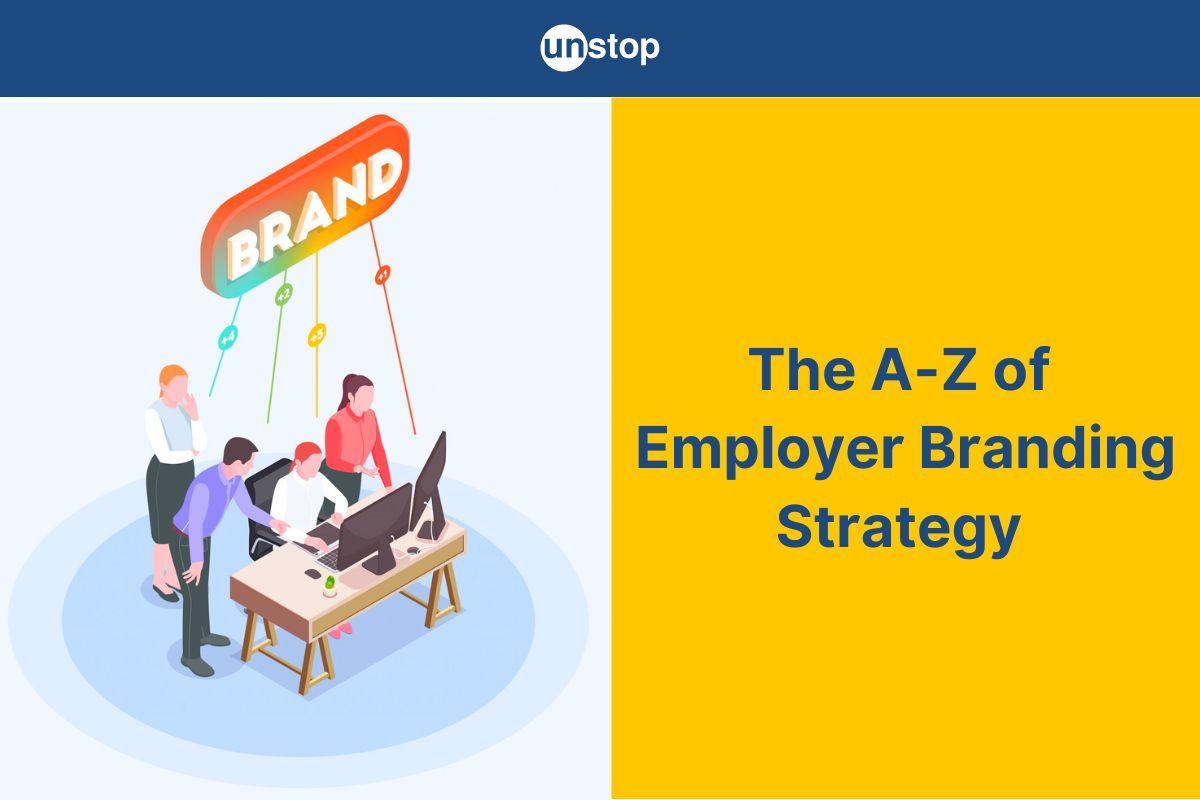
75%, i.e. one-third of job seekers consider a potential employer’s brand before applying for an open role. That’s the power of employer branding!
It’s also just one of the many reasons why building an effective employer branding strategy is a must for companies looking to attract and retain a skilled workforce in today's competitive job market.
Read ahead to take a deep dive into the concept, and explore effective tactics for building and enhancing your employer brand.
What is Employer Branding?
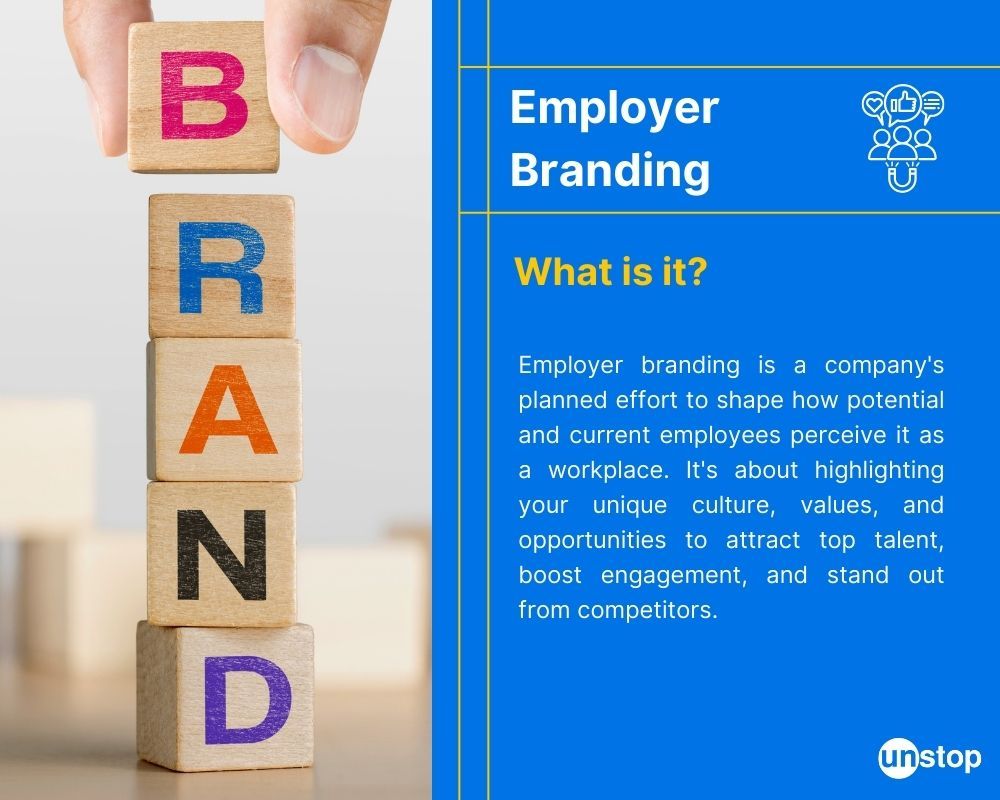
Employer branding refers to the strategic management of a company's reputation as an employer. It encompasses everything your company does, intentionally or unintentionally, to attract and retain top talent.
Employer branding strategy is, thus, not just about advertising job openings; it's about shaping how potential and current employees perceive your organization as a workplace.
Here are some key aspects of employer branding:
- Company culture: This includes your values, work environment, employee engagement, and benefits.
- Employee experience: This encompasses everything from the hiring process to onboarding, career development, and exit strategy.
- Reputation: This includes what people say about your company as an employer on social media, review sites, and word of mouth.
- Employer value proposition (EVP): This is a clear and concise statement about what makes your company unique and attractive to potential employees.
In essence, employer branding is about attracting the best talent, retaining your best employees, and boosting your overall brand.
A well-thought-out employer branding strategy aligns values with organizational goals to create a compelling narrative that resonates with potential candidates and existing staff members.
Employer branding strategies encompass various elements such as social media presence, employee engagement initiatives, career development opportunities, and diversity & inclusion programs. Successful implementation requires a deep understanding of the target audience and consistent communication of the organization's unique selling points.
Employer Brand - It goes beyond building an awesome product and offering amenities
Employers often believe that building an employer brand is about creating a unique product that customers value. And providing services like a ‘games room’ or free food to employees. While both of these elements impact a firm’s reputation, it takes more than these to build a solid employer brand - one that employees actively and independently trust and promote.
To state it in blunt terms, think about how your employees will answer the question, “How do you like working here?” The answer will most likely revolve around the day-to-day work environment more than the products or perks. This answer defines your employer brand
Take, for instance, the following two responses:
Response 1: “I believe in the product but long hours are a norm. Of course, the free coffee helps with the late nights and last-minute deadlines. But not with my fast evaporating social life.”
Response 2: “I joined the firm because I loved their products but I’ve fallen in love with how ideas go from concept to production. It’s a place where I feel my voice is genuinely heard - be it over a cup of coffee or during weekly catch-ups. I can’t wait to explore their talent development program.”
As a firm, you should be focusing on cultivating a culture where the second response is the norm.

Importance of Employer Branding Strategy
Differentiation from Competitors
In today's competitive job market, standing out from competitors is essential. An effective employer branding strategy allows companies to differentiate themselves by showcasing what sets them apart.
For instance, if multiple companies offer similar benefits or salaries but one has a reputation for employee development programs or flexible work arrangements due to its robust branding strategy, it will have an edge over others.
A well-thought-out strategy can help a company highlight its unique values, work culture, and growth opportunities. This differentiation can be crucial in attracting high-caliber employees who align with the organization's values. Moreover, when employees resonate with their employer's brand identity, they are more likely to stay long-term.
Enhancing Engagement and Productivity
Effective employer branding goes beyond recruitment; it also impacts employee engagement and productivity positively. A clear and compelling strategy helps employees understand the company's goals and values better.
When employees feel connected to these aspects of the organization, they tend to be more engaged at work. They are also motivated to perform better which leads to increased productivity levels.
Improving Brand Credibility
A strong employer brand strategy boosts corporate communication and turns employees into powerful and authentic advocates of the brand. This advocacy, in turn, improves brand reputation.
Customers and job seekers are more likely to trust the brand and its products and services if they see current employees advocating for it. Additionally, employees are also more likely to promote the brand in their network, improving the company’s reach and providing genuine and honest feedback about the brand's reputation.
How to Build an Employer Branding Strategy?
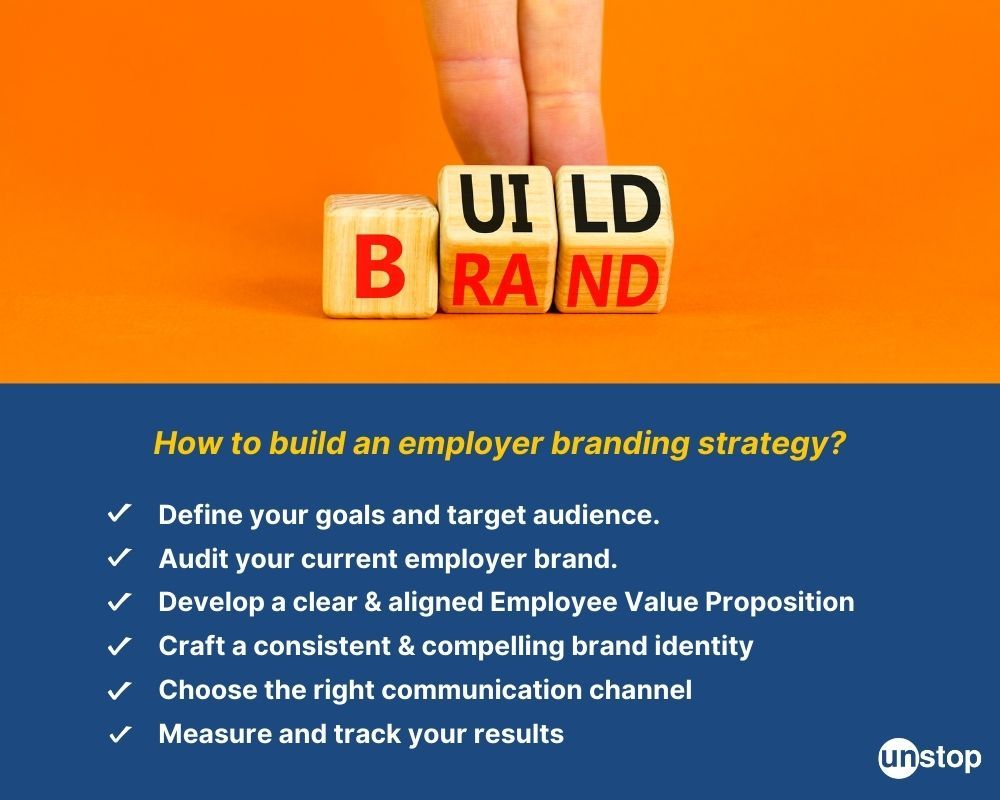
Here are the steps involved in creating an effective employer branding strategy:
1. Define your goals and target audience
The first step for any organization is to understand what it hopes to achieve with its employer branding - attract more qualified candidates, improve employee retention, or enhance the overall brand image? The answer to this question will help define your goal.
Also, companies should determine who are they trying to reach i.e. identify their ideal candidate profiles, considering their skills, experience, and values.
2. Assess current employer brand
Analyze online reviews, employee surveys, and other relevant data to evaluate how potential and current employees perceive the company as a workplace. This will also help identify areas where the company excels and areas for improvement i.e. the strengths and weaknesses in terms of employer branding.
3. Develop your employer value proposition (EVP)
Employer Value Proposition (EVP) is a unique set of offerings and benefits that a company provides to its employees in exchange for their skills, experience, and commitment. It encompasses what makes an organization attractive to potential and current employees, setting it apart from competitors.
For example, Google's EVP includes perks like free meals, on-site healthcare services, generous parental leave policies, and opportunities for career growth and development. These offerings not only attract top talent but also contribute to high employee satisfaction and retention rates.
4. Craft a consistent message and brand identity
Companies should develop a clear and consistent messaging strategy that reflects their EVP across all communication channels. This includes the career page, social media presence, job postings, and marketing materials. Use visual elements like logos, imagery, and videos to create a recognizable and memorable brand identity.
5. Choose the right communication channels
Where does your target audience spend their time online and offline? Utilize relevant platforms like job boards, social media, career websites, and industry events to reach potential candidates. Firms can also consider paid advertising if it aligns with their budget and strategy.
6. Track and measure your results
By monitoring key metrics like website traffic, job applications, employee engagement, and brand sentiment, companies can track the results of their employer branding strategies. Companies can also use analytics tools to assess the effectiveness of their efforts. Companies should regularly review and update their employer branding strategy based on their findings.
Additional Tips:
- Involve your employees in the process. Their insights and experiences can be invaluable in shaping your employer brand.
- Be authentic and transparent in your communication. Don't try to be something you're not.
- Be patient and consistent. Employer branding takes time and effort.
By following these steps and staying committed to developing an honest and powerful employer branding strategy, employers can attract and retain top talent, create a positive work environment, and ultimately achieve their business goals.
Strategies for Building a Strong Employer Brand
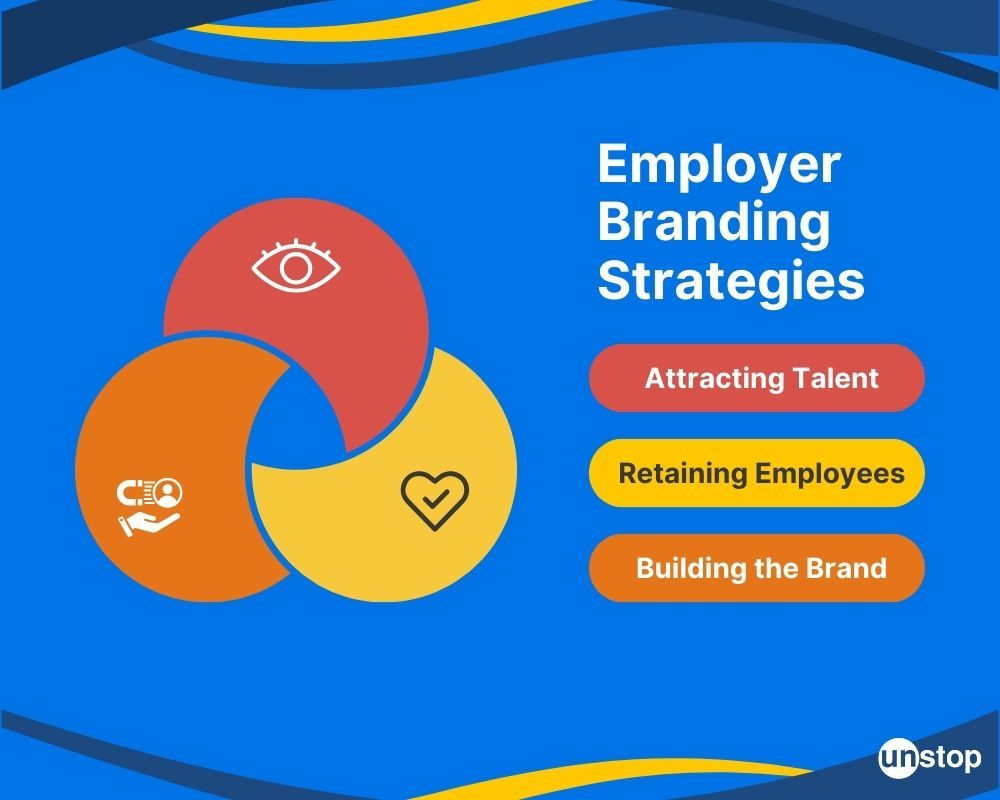
Attracting Talent
- Craft a compelling employer value proposition (EVP): Highlight what makes your company unique and appealing to your target talent. Be clear about your values, culture, and opportunities for growth.
- Leverage social media: Engage with potential candidates on social media to build relationships and increase brand awareness. Interact through comments, likes, and shares to create a connection with job seekers.
- Develop a Candidate Persona: Create candidate personas to grasp the preferences, motivations, and needs of potential candidates. By conducting employee interviews, companies can gather valuable insights to develop detailed candidate personas and attract them effectively.
- Engage in active recruitment: Participate in job fairs, industry events, and career panels. Partner with universities and colleges to connect with early-career talent and develop ad campaigns that reach your ideal candidates on relevant platforms.
- Create an engaging career page: A well-designed career page acts as a window into the company culture and values, showcasing what makes the organization unique. Include elements such as company videos highlighting a day in the life at the company, and photos of team members in action to build trust and engage with top talent.
- Utilize employee testimonials and stories: Your existing employees can be powerful advocates for your employer brand. Share positive employee experiences through videos, blog posts, and social media to showcase your work environment and culture authentically.
Looking to attract the best talent? Post your job listing for free on Unstop and connect with a community of 8 Mn+ students and working professionals.
Engaging and Retaining Employees
- Invest in employee development: Offer training, mentorship programs, and opportunities for career advancement. Help your employees grow and succeed within your organization.
- Promote a positive work environment: Foster open communication, collaboration, and recognition. Encourage work-life balance, organize team-building activities, and celebrate employee achievements.
- Offer competitive compensation and benefits: Ensure your compensation packages and benefits are attractive and competitive within your industry.
- Seek and act on employee feedback: Regularly conduct employee surveys and focus groups to understand their needs and concerns. Implement changes based on their feedback to show you value their input.
- Recognize and reward top performers: Create a culture of recognition and appreciation for high performance and contributions.
- Invest in D&I initiatives: Diversity & inclusion is not just branding; it's an investment in building a successful and sustainable future for your organization. It attracts top talent seeking diverse and inclusive workplaces, enhances your reputation as a socially responsible company, and fosters a strong, innovative workforce through belonging and engagement.
Looking for innovative ways to engage with employees? Enhance your employer brand strategy with a diverse set of employee engagement solutions, available on Unstop.
Building Your Brand
- Become a thought leader in your industry: Publish articles, participate in conferences and industry events, and share your expertise through various channels. Build your reputation as a knowledgeable and innovative organization.
- Engage with industry communities: Participate in relevant online forums, discussions, and social media groups. Connect with other professionals and showcase your company's expertise.
- Showcase positive experiences: Share stories of positive employee experiences through testimonials or case studies. Such firsthand accounts provide tangible examples of how organizational values are put into practice daily and create authenticity around the organization's claims.
- Collaborate with other organizations: Partner with businesses or non-profits whose values and goals align with yours. This can increase your reach and exposure to potential talent.
- Track and measure your progress: Use data and analytics to understand the effectiveness of your employer branding efforts and make adjustments as needed.
By consistently implementing these strategies and demonstrating your commitment to creating a positive workplace experience, you can attract and retain top talent, boosting your overall success.
How to Measure and Boost Your Employer Branding Success?
Track Key Metrics
By regularly tracking metrics like candidate conversion rates and employee satisfaction, you can gauge the impact of your efforts. For instance, if your company's candidate conversion rates are low despite high application numbers, it may indicate a misalignment between your branding message and actual work culture.
Seek Feedback
Feedback from candidates and employees is invaluable. Surveys provide direct insights into how your employer brand is perceived in the job market. Understanding what qualities candidates value in an employer or how employees feel about their workplace helps tailor your branding to attract and retain top talent effectively.
Adapt Based on Data Insights
Continuous refinement is key to boosting the success of your employer branding strategy. Analyzing data-driven insights allows you to make informed decisions on where adjustments are needed. For example, if feedback indicates that potential hires do not see a fit between their career goals and what your company offers, you can tweak messaging to better communicate opportunities for growth within the organization.
Examples of Strong Employer Brand Strategy
Here are a few examples of companies recognized for their strong employer branding strategies:
1. Google: Renowned for its innovative and employee-centric culture, Google offers perks like on-site amenities, professional development opportunities, and a focus on work-life balance. They actively showcase their company culture through social media and career pages, attracting top talent in the tech industry.
2. Netflix: Known for its "no rules" policy and unlimited vacation, Netflix attracts employees seeking flexibility and autonomy. They emphasize their unique culture and commitment to diversity and inclusion in their employer branding messages, resonating with younger generations and creative professionals.
3. Unilever: Focused on sustainability and social responsibility, Unilever attracts talent seeking to make a positive impact. They actively promote their purpose-driven mission and commitment to diversity and inclusion through their employer branding efforts, resonating with employees seeking meaningful work.
Best Practices for an Effective Employer Branding Strategy
Align Company Values with Employee Expectations
Developing an EVP involves aligning various aspects such as the company's values, culture, and rewards with employee expectations. For example, if transparency is one of the core values of the organization, this should be reflected in how communication flows within the company. Similarly, if professional growth is encouraged through training programs or mentorship opportunities, this aspect should also be part of the EVP.
Tailor Branding Efforts to Candidate Personas
When employers understand what resonates with their target audience, they can craft messaging that speaks directly to potential candidates' interests and aspirations. Tailoring employer branding efforts based on candidate personas enhances relevance and effectiveness.
However, while this increases the likelihood of attracting the right talent for specific roles, it’s also a time-consuming process as it requires thorough research. Companies should also be careful to not overlook certain traits or preferences important to some candidates.
Ensure Consistency in Messaging
Consistent employer branding messages across platforms reassure candidates and employees. When the company's values align with its actions, trust is established. For instance, if a company promotes work-life balance in its messaging but demands long hours from employees, credibility is compromised.
Maintaining consistent messaging involves aligning recruitment materials, social media posts, and internal communications. This cohesion reinforces the organization's commitment to its promises. By showcasing a unified front in all interactions, both potential hires and current staff members feel secure about the company's culture.
Balance the Pros & Cons of Leveraging Social Media
Social media channels provide a cost-effective way to showcase your employer branding strategy. By utilizing platforms like Instagram, LinkedIn, or Twitter, companies can reach a vast audience without hefty marketing expenses. This approach is particularly beneficial for small businesses or startups with limited budgets.
However, an overreliance on social media attracts the risk of negative feedback going viral. There’s also difficulty in controlling messaging consistency. By providing handy dos and don’ts to employees and addressing negative reviews and feedback promptly and professionally, companies can efficiently utilize social media platforms.
Provide Appropriate Resources to ‘Employee Brand Ambassadors’
Providing training sessions and resources to employees who act as brand ambassadors amplifies their impact significantly. By offering guidance on creating engaging posts or sharing relevant news updates, companies empower their staff to effectively represent the brand online.
Companies can offer regular workshops or webinars focusing on effective social media practices, create guidelines outlining what type of content is suitable for sharing online, and provide access to visual assets like logos or templates that maintain brand consistency across platforms.
These resources ensure that employees understand how to communicate key messages accurately while showcasing what makes the organization unique.
Build a Career Page with User-Friendly Navigation
Clear and user-friendly navigation on your career page is essential for providing a positive candidate experience. When job seekers visit your site, they should be able to easily find job postings, information about career growth opportunities within the company, and details about what sets your organization apart from others.
An intuitive layout that guides visitors through different sections seamlessly not only enhances engagement but also encourages candidates to explore further.
Closing Thoughts
In conclusion, a well-crafted employer branding strategy is pivotal in attracting and retaining top talent. By defining a compelling Employee Value Proposition (EVP), creating engaging candidate personas, and leveraging social media effectively, organizations can enhance their credibility and trustworthiness.
Utilizing current employees as brand ambassadors and maintaining an interactive career page are crucial steps towards building a strong employer brand. However, to excel in the competitive landscape of talent acquisition, continuous measurement and refinement of your employer branding efforts are essential.
Frequently Asked Questions (FAQs)
1. What is the significance of developing a candidate persona for effective employer branding?
Creating a candidate persona helps tailor your employer branding efforts to attract and engage specific talent segments. By understanding their preferences, motivations, and challenges, you can craft targeted messaging that resonates with potential candidates.
2. How can social media be leveraged for successful employer branding?
Social media platforms provide an avenue to showcase company culture, values, and employee experiences to a wider audience. By engaging with followers authentically and sharing compelling content, organizations can enhance brand visibility and attract top talent effectively.
3. Why are current employees valuable as brand ambassadors in employer branding strategies?
Current employees serve as authentic advocates who can share firsthand insights into the company culture, work environment, and opportunities. Their testimonials carry credibility and help build trust among potential candidates considering joining the organization.
4. How can companies create an engaging career page to attract candidates effectively?
An engaging career page should feature compelling visuals, authentic employee stories/testimonials, and clear job descriptions & requirements. It should also highlight company values/culture & provide easy navigation for a seamless user experience. Regular updates keep content fresh & relevant for potential candidates browsing the site.
If you liked this, you might also be interested in the following:
- Employee Empowerment: Understanding Meaning, Benefits & Strategies
- Employee Satisfaction: Uncovering Its Importance & Strategies
- Employee Grievance: Understanding Types, Causes & Solutions
- Employee Appraisal Comments: 115+ Phrases Divided By Skills & Roles
- Employee Referral 101: Unlock Benefits, Best Practices & Top Schemes
I’m a reader first and a writer second, constantly diving into the world of content. If I’m not writing or reading, I like watching movies and dreaming of a life by the beach.
Login to continue reading
And access exclusive content, personalized recommendations, and career-boosting opportunities.
Subscribe
to our newsletter
Blogs you need to hog!
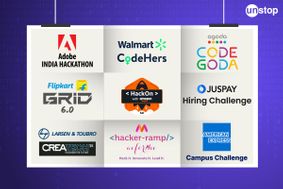
Organize Hackathons: The Ultimate Playbook With Past Case Studies

What is Campus Recruitment? How To Tap The Untapped Talent?
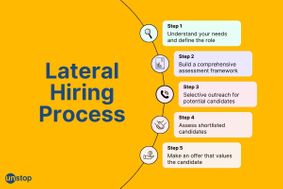
Lateral Hiring: A Complete Guide To The Process, Its Benefits, Challenges & Best Practices
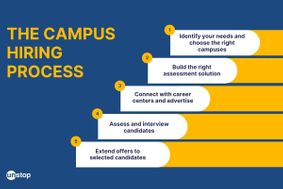












Comments
Add comment